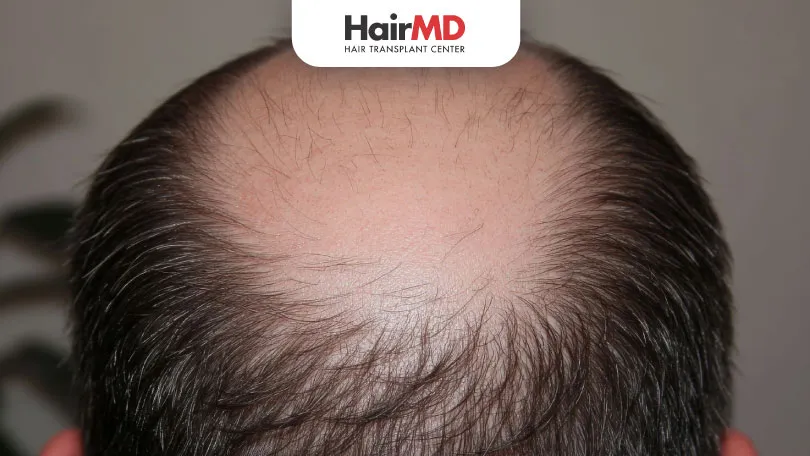26th May, 2025

Hair thinning often starts subtly—slightly wider parting lines, shorter regrowth cycles, or strands that feel finer. Behind these signs lies a key process: hair follicle miniaturization.
Left unaddressed, this process can lead to baldness. But here’s the good news—when detected early, hair follicle miniaturization can often be slowed or even reversed.
At HairMD Pune, we specialize in diagnosing and treating miniaturization before the damage becomes irreversible, showing how hair follicle miniaturization be reversed with the right care.
What’s covered in the article?
- What Is Hair Miniaturization?
- Is Miniaturization Reversible?
- How to Detect Miniaturization Early
- FAQs
- Conclusion
What Is Hair Miniaturization?
Hair follicle miniaturization is a gradual biological process where healthy hair follicles shrink due to hormonal sensitivity—especially to DHT (dihydrotestosterone). These miniaturized follicles produce thinner, shorter, and less pigmented hairs. Eventually, they stop producing visible hair altogether.
This process plays a central role in androgenetic alopecia (male and female pattern baldness) and is often the earliest clinical sign of hair loss.
Key Signs of Miniaturization:
- Hair becomes fine, wispy, and translucent in certain areas
- Hair density reduces around temples, crown, or parting
- Increased hair fall with slow regrowth
- Hairs appear shorter despite regular growth cycles
Is Miniaturization Reversible?
Reversing the miniaturization of hair follicles is possible, especially in cases like alopecia areata. While it’s more challenging with male or female pattern hair loss, there’s still hope! With the right treatment and early action, you can see real improvement—even in tougher cases. Don’t wait to take control of your hair health!
Medical Treatments to Reverse Hair Miniaturization
- Finasteride (DHT Blocker)
Finasteride reduces DHT levels by inhibiting the enzyme 5-alpha reductase. Lower DHT levels slow or stop the miniaturization process. Many patients experience thicker regrowth over 6–12 months of use.
- Minoxidil (Topical Vasodilator)
Minoxidil improves blood flow to scalp follicles and stimulates the anagen (growth) phase of the hair cycle. It’s particularly effective for regrowing hairs that have recently miniaturized.
- Platelet-Rich Plasma (PRP) Therapy
PRP involves injecting your own platelet-rich plasma into affected areas to stimulate dormant follicles. It’s rich in growth factors and cytokines that can reverse miniaturization and promote thicker hair.
- Low-Level Laser Therapy (LLLT)
LLLT uses red light wavelengths to improve energy metabolism in hair cells, increase blood flow, and reduce inflammation—supporting the recovery of miniaturized follicles.
How to Detect Miniaturization Early?
Scalp thinning isn’t always easy to see. That’s why HairMD Pune uses trichoscopy—microscopic scalp imaging—to detect subtle changes in hair shaft diameter, density, and follicular spacing. We also compare digital scans over time to track progress and ensure treatment efficacy.
Why Early Treatment Matters
Once a follicle has fully miniaturized or been replaced by fibrotic tissue, regrowth is unlikely. The best outcomes are achieved within the first few years of noticeable thinning.
Here’s what untreated miniaturization often leads to:
- Progressive thinning that spreads from temples or crown
- Permanent bald patches due to follicle atrophy
- Lower success rates with hair transplants in scarred regions
Lifestyle Triggers That Accelerate Miniaturization
- Chronic stress and high cortisol levels
- Crash dieting or nutritional gaps
- Excessive scalp buildup or poor hygiene
- Smoking and poor sleep cycles
At HairMD, we recommend a holistic approach—combining medical treatments with lifestyle corrections to improve long-term results.
Frequently Asked Questions
Q: Can I reverse miniaturization naturally?
A: Natural remedies may slow the process, but only medical treatments can significantly reverse follicle shrinkage. Early diagnosis is key.
Q: How long before I see improvement?
A: Most patients see noticeable changes in 4–6 months, with optimal results at 12 months. This depends on severity and consistency.
Q: Is miniaturization more common in men?
A: Yes, but women also experience miniaturization, especially around the parting line and temples.
Do You Know?
Nearly 250 Patients Visit HairMD
Everyday For Various Hair Concerns?
(Your journey to healthier and fuller hair starts here!)
Meet Our Dermatologists
Conclusion
Hair follicle miniaturization doesn’t have to lead to baldness. With proper diagnosis and early treatment, the process can be slowed—or even reversed.
At HairMD India, a leading hair specialist in Pune, we offer advanced diagnostics, tailored treatment plans, and ongoing support to preserve and restore your hair.
Don’t wait for visible thinning. Act early and give your follicles the help they need to regrow stronger and healthier.
Want to protect your hair before it’s too late? Book a consultation with HairMD’s experts today.
Further Reading
PRP Therapy for Hair Loss in Pune 2026 – Cost, Effectiveness & Results
Complete guide to PRP therapy for hair loss in Pune 2026. Learn about costs (₹3,000-15,000/session), 70-80% success rates, procedure details, and how it compares to FUE and medications.
Ethical Hair Transplant Practices – Why HairMD Pune Is Trusted?
Discover what ethical hair transplant practices look like and why patients trust HairMD Pune. Learn to spot red flags, verify surgeon credentials, and make informed decisions for your hair restoration journey
Low-Cost Hair Transplant Clinics in Pune – Risks & Warnings
Discover why ultra-low-cost hair transplants in Pune are dangerous. Learn red flags, true costs, and how to verify surgeon credentials before risking your scalp health.
Top Hair Growth Treatments for Women: Your Ultimate Guide
Find effective hair regrowth treatments for women. Explore solutions like PRP, medications, and more to combat hair loss with expert advice from HairMD.










